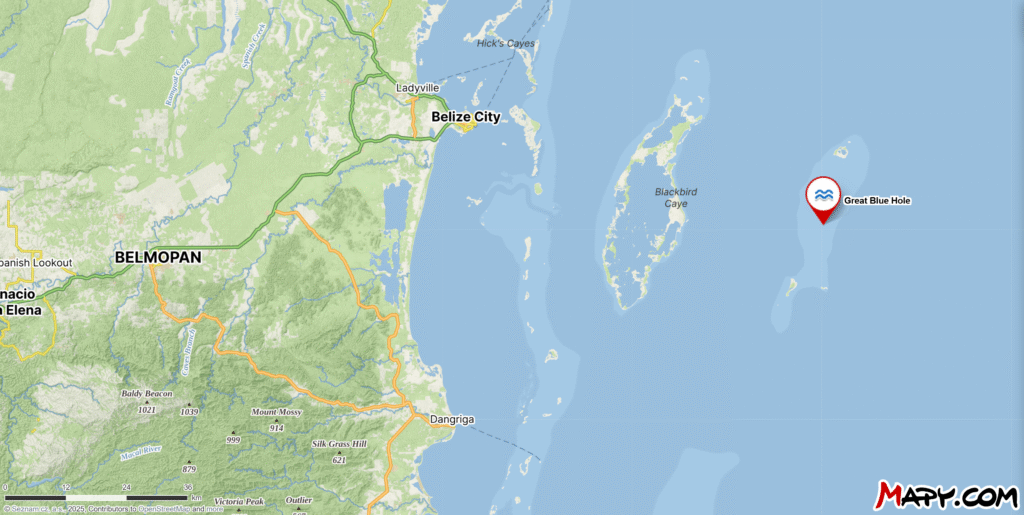- The Red Queen Hypothesis
- Orangey Minerva
- Yellow Dust
- The Green Flash
- The Great Blue Hole
- Indigo Buntings
- The Violet Crown
- 2025 Version
- Original Version

The Great Blue Hole
The Mesoamerican Barrier Reef System, stretching from the tip of the Yucatan Peninsula to Honduras, is the world’s second-largest, after Australia’s Great Barrier Reef.
A 190-mile (300-kilometer) section eponymously takes the name of the nation whose coast it lines. Tourists and diving enthusiasts come from around the world to visit the Belize Barrier Reef.
The diversity and beauty of this stretch make every inch a wonderland, but a specific spot houses one of Earth’s most striking locations.
The Belize Barrier Reef contains three atolls, one of which is Lighthouse Reef. About 50 miles from Belize City, this ocean strip looks like a 22-mile turquoise blob from above. Zoom into the satellite views, however, and something more geometrically pure emerges: a stark, dark-blue cavity.
This pleasing circle is the Great Blue Hole.





A blue hole is a cave system, usually formed by dissolving karst processes, that has been submerged by ocean water.
Appearing like the cerulean version of the Red Spot of Jupiter, the Great Blue Hole is aptly named. Though it’s not the deepest, it is the world’s largest by volume. The tiny blue dot in the satellite image above is more than 1,000 feet wide (318 meters) and sports a surface area of 760,500 square feet (70,650 square meters)!
The opposing blue colors come from the depth of the cavern. The Great Blue Hole is more than 400 feet (125 meters) deep. Sunshine hits the shallow waters around its exterior, making them lighter, while the abyss gobbles rays, leading to dark blue.
In addition to its gargantuan scale, the Great Blue Hole also happens to be quite majestic. Its blue-on-blue contrast is geometrically vivid, but it also wears a green ring, as coral pokes above sea level to create levels of circularity.

Word got out to the world about the Great Blue Hole in 1971 when famed aquanaut Jacques Cousteau explored the reef, naming the hole one of the five best scuba diving sites on Earth.
Subsequent expeditions mapped the gaping chasm and gathered specimens in the attempt to probe its origins. Scientists found ledges at four different depths and stalactites, which suggest the hole formed like a normal sinkhole on dry land over thousands of years. Its stages correspond to dates approximately 153,000, 66,000, 60,000, and 15,000 years ago, during ice ages when ocean levels were much lower. When the ice age ended, sea levels rose, and the sinkhole became the Great Blue Hole, mixing speleothems with seawater.
Discovery Channel took Cousteau’s praise one step further.
They named the Great Blue Hole one of the “10 Most Amazing Places on Earth.”
They produced a documentary in 2018 about the hole’s exploration, the same year a scientific team plumbed the chamber for a three-dimensional image.
While much of the footage reinforced the hole’s reputation for resplendence, filled with reef life and cave fingers, this location did not turn out to be all rainbows.
About 300 feet below the surface, they discovered a layer of hydrogen sulfide. Combined with the lack of light and oxygen, this stratum bars life.
When they reached the bottom, they also found the bodies of two divers, a stark reminder that nature’s complex splendor often arrives with deadly power.
Still, this unique blue dot is a terrestrial (and oceanic) highlight.
Further Reading and Exploration
The Great Blue Hole in Belize – Travel Belize
Great Blue Hole of Lighthouse Reef Atoll – Caribbean Geology Into the Third Millennium/University of the West Indies
Great Blue Hole of Belize – Discovery Live
Belize Barrier Reef Reserve System – UNESCO

The Great Blue Hole
Travel to Central America with me today to one of the more striking spots on our rocky orb: The Great Blue Hole of Belize.

We don’t often associate sinkholes with the ocean, but TGBH is a spectacular version of a phenomenon called, fittingly, blue holes. They are marine caverns or sinkholes, which have openings at or near water surfaces. On land, most sinkholes form in limestone via karst processes – a chemical dissolution of soluble rock. If conditions are right, karst processes form caves.
If you’re wondering how this giant void formed in the ocean, good on you. The feature was born thanks to glaciation, as long as 150,000 years ago, on land when sea levels were much lower. Eventually worldwide levels rose and the above-ground cave became a below-ocean wonder.
In 1971 the inimitable Jacques Cousteau brought his famous craft, the Calypso, to probe the depths of the hole. The expedition confirmed the hole’s origin story and witnessed stalactites from submerged portions. The popularity of the site soared after Cousteau’s visit and it is now a scuba-diving Mecca.

The contrast between the blues of the water arises due to the differences in depth. Since the hole is nearly vertical, the depth increases dramatically and suddenly, causing a deep midnight shade, which is surrounded my aquamarine shallows. Near the surface and around the hole, divers encounter typical reef flora and fauna, making this spot a true “bucket” list destination.
In late 2018 a scientific team used a submersible to explore and map the depths of the hole. They were armed with sonar and high-tech cameras. Check out the video below for footage of the expedition, a look at some of the giant stalactites, and a three-dimensional model of the entire hole!
Further reading and exploration
My Father, the Captain: My Life With Jacques Cousteau by Jean-Michel Cousteau
The World’s Great Wonders: How They Were Made & Why They’re Amazing – Lonely Planet
Diving and Snorkeling in Belize – Lonely Planet
Into the Blue Hole – Discovery Channel
The Great Blue Hole on Google Earth












